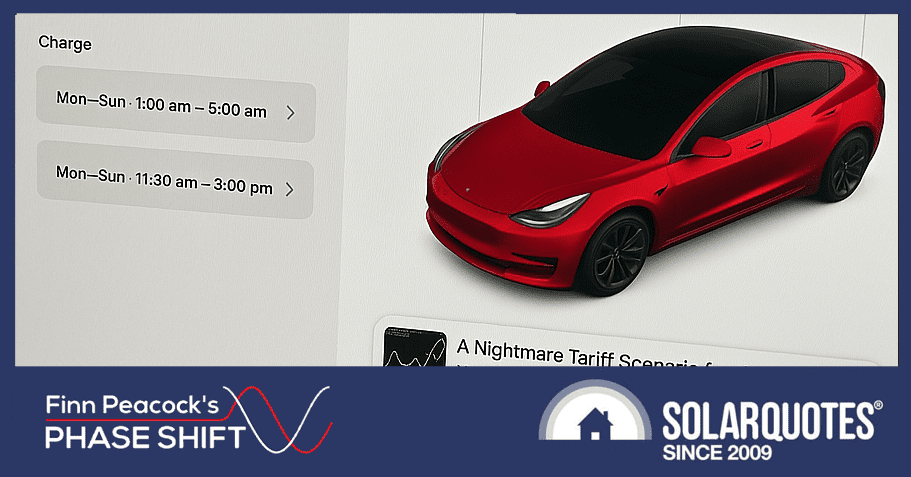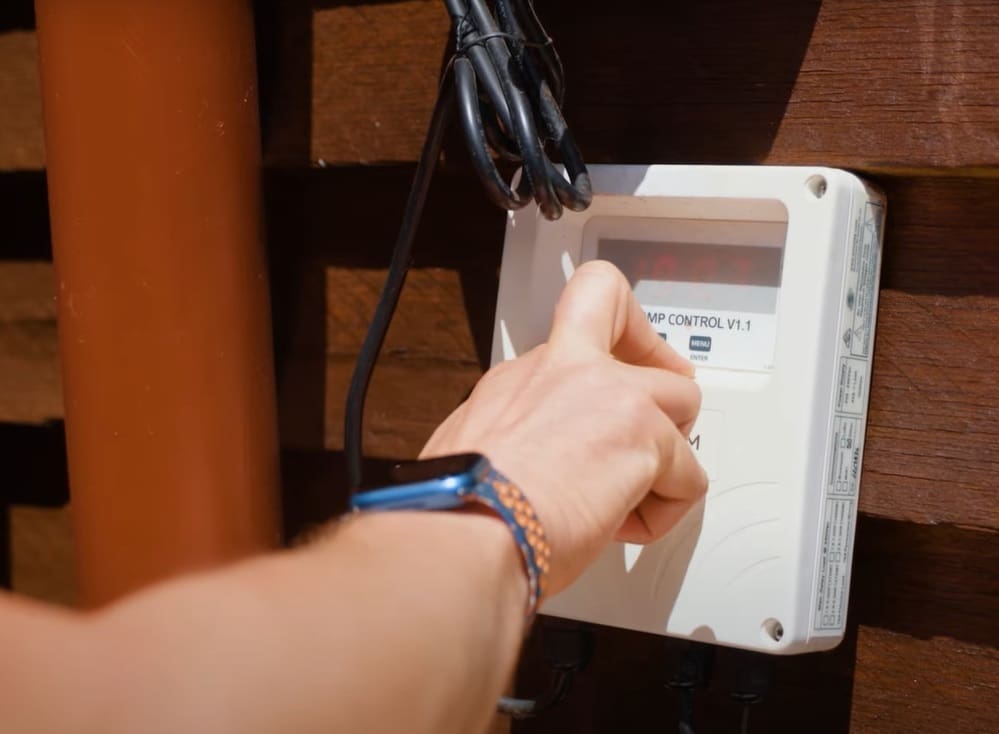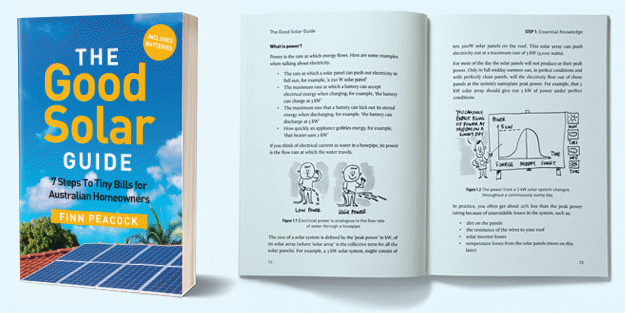 In a world full of ‘smart’ energy tech, AI-driven optimisation, and dashboards that would make a Qantas cockpit blush, I’ve come to a confronting conclusion: the future isn’t clever. It’s just… timers.
In a world full of ‘smart’ energy tech, AI-driven optimisation, and dashboards that would make a Qantas cockpit blush, I’ve come to a confronting conclusion: the future isn’t clever. It’s just… timers.
Three things happened recently that reminded me the more complicated the system, the more things that can (and do) go wrong.
Systems Arguing Over Excess Solar
First: we installed a SigEnergy AC EV charger at the house of our marketing manager Jono. He chose SigEnergy because it supports OCPP, and he’s with Amber Electric whose prices go up and down like a rollercoaster.
His goal? To smart-charge his EV in two ways:
- From surplus solar during the day;
- From the grid when prices go negative (yep, negative — Amber will actually pay you to charge).
It should’ve worked beautifully, but the reality was another matter (check out our video for the full saga). Instead, Amber’s smart software curtails solar exports when prices go negative – to avoid customers paying to dumping power into the grid. But that means ChargeHQ, the solar-charging app, can’t see any surplus solar… so it refuses to charge. The two systems were arguing over Jono’s excess solar.
Until the engineers fix it (handy that Amber and ChargeHQ are the same company), the workaround is simple: a built-in timer that charges from 11am to 3pm. That’s when there’s usually either plenty of solar or cheap grid electricity. Not perfect, but it works.
Systems That Stop EV Charging
Second: I saw complaints about Origin’s EV charging deal – the one where they guarantee a full charge when you need it, and only charge you 8c per kWh. Sounds great… until someone tried to top up at a Tesla Supercharger and it refused. I’m guessing the system couldn’t work out the car wasn’t at home, so it blocked the charge. Not helpful. Again, fixable. But it shows how fragile clever systems can be when they depend on everything talking to everything else, perfectly.
Systems That Don’t Do What They Promise
Third: Tesla recently launched a ‘Charge on Solar’ feature that only charges your car using excess solar. Nice idea – until it refuses to charge even when I’m exporting 10kW to the grid. I think it’s clashing with my Powerwall’s VPP controls, but who knows. And it definitely doesn’t work with the Mini. All Tesla gear, and still a fight. More smarts, more complexity, more unpredictability.

A simpler solution is available: timers.
A Tale As Old As Timers
At my place, almost everything runs on timers.
- Pool pump? Timer.
- Pool heat pump? Timer.
- Dishwasher? Timer.
- EV chargers? Timer — because trying to coordinate a Mini and a Tesla through ChargeHQ doesn’t work.
- Battery? It’s on a plan that makes daytime power cheapest. No extra smarts needed.
I reckon I’m only a couple hundred bucks a year worse off than someone with a fully optimised Home Assistant setup, half a dozen API integrations, and a switchboard full of Catch Control relays. But I’m not on home automation forums. I’m not explaining my energy system to my family. And if I drop dead, no one has to rip out a computerised home assistant just to boil a kettle.
So here’s my advice:
If you have solar and a battery and your retailer offers a decent time-of-use tariff, with cheap daytime and overnight windows, forget the AI and just use the timers already built into your appliances. Pool pump, dishwasher, EV charger, hot water heat pump, they’ve all got them.
You’ll get 90% of the savings, and 10% of the headaches.
And your toaster won’t need a firmware update.

 RSS - Posts
RSS - Posts



One of the reasons I ended up using NetZero’s automations is that they’re not only able to be time-based, which as you say is often all you need, but allow you to attach various other triggers to that time-based control.
We live in a world where standards rule and try to define what happens…at the same time 100% standards compliant gets to market late, or more likely not at all. We end up with a scenario where every manufacturer thinks , like the 1984 novel, that all devices are equal, but theirs is more equal and as such needs to be the boss in a peer to peer arrangement. We end up with a houseful of devices that can all communicate, just not well and most likely not in a way that can facilitate what we want. Devices like this dont generally update well or often and so what you have is what you get left with.
I use Home Assistant to be the self appointed king of the peer devices in my house. Generally there is someone world wide that is passionate about device X and we end up with a reasonable device interface to use with HA. with appropriate forecasting for solar so I can see what will happen in coming hours to days I can make informed decisions about what should occur and generally
Hi, Have a PW3 2 x EVs 13kw solar + ACDC Split 7kw air con (which runs all-day ). One 16 amp Tesla wall charger & one 10amp Tesla mobile charger. You need to tell Tesla about the home chargers to turn on charge on solar features. It only charges on solar no problem. The only caveat is that there must be 1 to 1.5 kw of spare energy. With the PW3 in place it changes the duck curve so that by 8:00am I’m pulling 10kw/hr until 4:30pm. Solar Summer 100kw per day, winter 55kw overcast day …
The PW3 has now made me off the grid if I wanted to.
The purchase off the 7kw Air con has been a game changer. It consumes 1kw to 1.8kw/hr. At night it consumes 0.4kw. I normally programme it to turn off at 7:30pm it turns on at 7:45am runs all day heating/cooling the main kitchen / dining/ living areas.
I can’t believe how seamless PW3 has made it. All on a single phase setup
cajole device X to do what I want it to do with Device Y.
But there are downsides to HA. It’s constantly updating so unlike the devices themselves the updates come thick and fast. Sometimes the passionate guy who wrote the controller for device X focused on a set of functionality that isn’t what you want so you have to try and get them to change the control, or the device OEM can only see $ that will come from cloud control and their view of the world where their device is the king of the peers and they’re not sharing any info on how their device works….so HA control will come but it’ll be delayed and stunted….
And lastly the reality that to get Device X to play nicely with Device Y under HA will require you to put in significant effort. But once done you’ll have achieved something good, and something that’ll likely work for a good while before you need to update it. The last bit likely see’s 95% of the consumer world excluded from this. The 5% who aren’t will control their world
I have been agreeing with this idea for some time.
I use Home Assistant because it will read & control all my diverse hardware. But I have yet to automate the system,
The problem I see with simple systems comes when we integrate V2G into the system. I feel then that we will need control over the total system.
I am a Red Energy customer, who recently went to the Energy Conference in Sydney where aspects of V2G were high on the agenda, Essential Energy, SigEnergy & the Ford F150 are now working & available as V2G. Expensive but here. V2G AC is in trial too. However, after enquiring to Red, it seems they are not even thinking about V2G yet. I am a customer who will probably update to a V2G vehicle in the next 12 months or so. The Energy retailers need to be ready.
Home Assistant I feel has the advantage that it will work with virtually anything. I feel that it will soon encompass AI to generate the code to control itself. The Revolution, I feel, will will start there.
I think you’re right that AI will come into play at some point. However, AI on its own won’t be much use unless there is full interoperability (via international standards, etc) among all components of the system ie. grid, energy retailers, solar systems, batteries, EVs, etc, etc.
Maybe one day there will be available an AI-based “black box into which one will be able to simply plug in the various components or systems and, very simply, specify the outcomes that are wanted, perhaps specified in order of priority eg.
1. Minimise overall cost;
2. Ensure house battery has sufficient charge for overnight usage every day and also be able to provide backup power for at least X hours when there is a grid outage;
3. Ensure EV has at least X% charge by 7am every morning
Now, I’d buy a system that could do that (providing the price is right) !!
I find Home Assistant core automation a bit basic and lacking as such Ive added Node-RED to my HA and after flailing around a bit to get my head around how it works I now have automation’s that work well to 1) control ceiling fan speeds based on in room temperatures (cause all modern fans have timers….but what I really want is the fan to turn off when I get cold not when its been on for some arbitrary time) 2) control solar hot water boost heater to only run when there’s excess solar that would otherwise be exported and 3) to control the multiple Aircons in the house to run when there’s a need (temp based deviation from ideal) and there’s spare solar available so I don’t pay anything for the aircons running.
2) and 3) together see my house consume up to 50kwhrs a day in summer, yet of that 50kwhrs Ill only pull about 8kwhrs from the grid. As yet I don’t yet have the new sigenergy beast installed rather only an old tired 6kw inverter and 6.5kw solar that today is good for 5.2kwhr
Reluctantly, I totally agree Finn.
I’ve had different but similar problems with clients installations over the years, that have competing control systems.
Sometimes we can be too ‘smart’ for our own good.
(And I work for the Smart Energy Council.)
I use Origin’s 8 cent charging plan. Never had that issue ( so far, with my BMW)
Only issue I have is the cost is more like 15 cents kw/h
Car: consumed 26 kw/h
Power consumption meter: 26 kw/h
Origin credit 22 kw/h
Maybe because my house doesn’t have a smart meter….. yet.
But Origin do say the system is in “Beta” testing.
Im not complaining, it’s still cheap and AGL’s equivalent plan only works with a smart meter.
Why didn’t Jono have an always charge price setup in charge hq, it would’ve charged but it still probably would’ve taken power from solar first unless it’s completely turned off
Since I have worked from home for the past 27 years I find that I don’t need timers. I charge the car when the sun is shining. I turn the hot water service on when the sun is shining, if it looks as if the evacuated tube solar hot water is not going to get the water hot enough.
We also try to run the appliances like dishwasher and washing machine when it is sunny.
It seems my sensors, eyes, do a pretty good job.
Couldn’t agree with you more !!
And it’s so thoroughly refreshing to hear someone recommending simplifying things in a world of ever-increasing complexity and so-called “smarts”, most of which is neither necessary nor even desirable.
Seriously, how many people actually need to use – or even know (or care to know) how to use more than perhaps 10% of the full capabilities of their mobile phones, video recorders, TVs, car infotainment systems, etc ?
Whoever first expounded the KISS (Keep It Simple, Stupid) principle was as genius as good ol’ Murphy (of Murphy’s Law fame).
As I drive 85 kilometres to work one way, how will I charge from solar, start time at 6am finish 5pm.
Wife works 8am till 3pm and then picks the kids up from school, at 4.30pm takes them to sport.
No solar power charge then.
Kids play different sports areas on Saturday so again n solar charge.
Hi John,
I’d suggest you need to petition the boss for charging at work, because we should all be doing that anyway, it must be the norm in the future.
Better still get a job closer to your house… if you’re spending 10hrs(?) a week commuting that’s a lot of tyre wear and life wasted.
Thank you for the sanity check.
My solar installer recommended i wait until i go through a winter before putting my hot water on to a timer, as i only get good sun on my panels for 5 or 6 hours in the morning. No doubt it will be less in winter, and power for the hot water is the cheapest power if you have to buy it.
We are only using about 2kwh a day for hot water, so its not killing me paying for it, but all the same I am keen to go for a timer for it if i can!
Thank you Finn and all the commenters.
This is a very important and timely discussion ATM.
I will take your advice and keep it simple for now.
Great article. Simple is best. Timers all the way.
I use a 240V 10A Meross smart outlet with my PHEV. It is controlled by Apple Homekit (hope that doesn’t start a debate!). An automation starts charging after 10pm (off peak here). If, like today in Sydney, there is plenty of sunshine then I will manually charge the car via Homekit, instead of exporting to the grid. That is, if I notice that the “excess” solar is high enough.
My only gripe is that the Tesla Powerwall app (and supplementary apps like Powerwall Monitor) are not able to notify me when grid export goes above or below a user-selected value. I toyed with trying to learn the Tesla API to do this but it got too complicated.
It is a challenge to find smart outlets (or even conventional timers) that can take 10A for several hours, despite being rated at 10A.
I’m the developer of three Tesla integrations in Home Assistant (Teslemetry, Tessie, Tesla Fleet), with a fourth in the works (Bluetooth). While I’ve seen my users do amazing things with Amber, I actually get the best results letting my Powerwall in autonomous mode and charge on solar decide what to do on a regular TOU tarrif.
However, the Origin Battery Maximiser VPP tries to charge an discharge my battery so aggressively that I end up putting it into permanent snooze.
If Tesla was more open this could all be better, but otherwise I sort of agree, timers get you most of the way there, especially in mixed brand setups.
I’m with Amber and have a SolarEdge inverter and charger. I have no trouble charging my Tesla on excess solar. I don’t use Amber for EVs because it seems to be based on charging with cheap power from the grid, whereas I use my own solar for all charging. I guess I miss out on charging when feed-in prices are negative, but then I save my solar in my battery and then export when grid prices are high.
So no problems with EV charging but I agree that for many other loads timers are the simplest option.
Home Assistant + evcc.io is the way to go. I have a Tesla Powerwall 2 and a Tesla EV in a single phase and using OVO EV plan with no gas. The only way to ensure I have full control and not going to trip the mains, is to constantly monitor the grid import and then slow down the EV charging accordingly. This is a very complicated setup and I still haven’t quite nailed it.
I have been pondering this issue with solar curtailment for a while. Estimating the ‘available’ solar power during that curtailment period is non-trivial due to the non-linear nature of PV panels.
The interim solution Im working with is an incremental ramp up of the controllable loads to pseudo test the available solar capacity, until I hit the grid import point. Works for some loads like smart EV chargers but not for others like pool pumps or heaters.
Agree that for the bulk of the loads, a timer is likely a 90% solution. Pair that with a decent battery and it can optimize the last 10%.
The smarts are still useful for overcast days, manual control overrides and for those pesky price spikes.
For me the nice midground is timers in home assistant. That way I can manually override if I need to, and I can build in some limited smarts to accounts for bad weather days.
Simples is good!
ChargeHQ has scheduled charging that over rides the default state of operation such as only using excess solar PV. Used it for ages with a free energy period. It’s very easy to use.
KISS is generally a good idea however let’s not throw out the baby with the bathwater, there are optimisations which are not THAT hard or expensive to do.